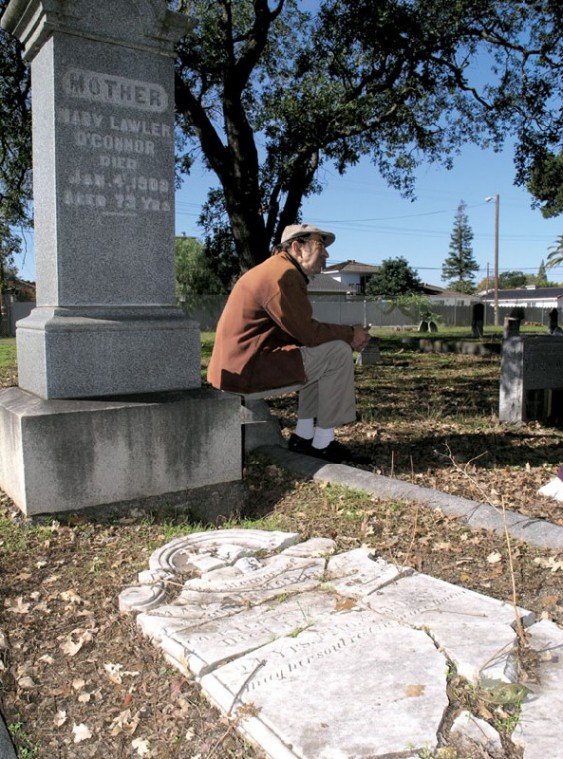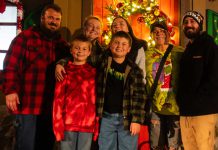Gilroy
– It’s not the oldest graveyard in the South Valley, but it’s no
doubt the best hidden. Tucked down a neighborhood alley, the
little-known Old St. Mary Cemetery is where many pioneers of
Gilroy, Morgan Hill and San Martin rest in peace.
Gilroy – It’s not the oldest graveyard in the South Valley, but it’s no doubt the best hidden. Tucked down a neighborhood alley, the little-known Old St. Mary Cemetery is where many pioneers of Gilroy, Morgan Hill and San Martin rest in peace.
Saturday morning, I joined a dozen tombstone buffs on a cemetery walking tour led by Gilroy Historical Society docent Connie Rogers. As we started to cross Gilroy’s Church Street from the St. Joseph Family Center, a hearse and funeral convoy started to pass in front of us. It turned into the St. Mary Church’s parking lot.
“An ominous warning for us cemetery tourists?” I suggested to the group.
No “sign,” however, must have been intended. Our cemetery tour-group managed to make it safely across the busy street. We made our way down a quiet alley and shortly found ourselves standing at the gates of the chain-link fence surrounding Old St. Mary Cemetery. Rogers unlocked the gate and we soon strolled into the graveyard grounds where Victorian monuments slowly decay under a canopy of ancient oaks.
The docent stood on a tree stump and described the history of the cemetery. It was established in 1865 but the first burial took place in 1866. Apparently, several South Valley pioneers had done a bit of grave hopping during the 19th-century, I learned. Pioneer Martin Murphy, Sr., tired of making the long trip to the Mission Santa Clara to pay respects to dead family members, established a cemetery in what’s now San Martin. (The village received its name from the St. Martin of Tours cemetery chapel Murphy named after his patron saint.) After the chapel burned down, South Valley church authorities decided to move the 22 bodies to the St. Mary’s Parish cemetery, Rogers said.
Their “final” final resting place, I noted.
Our group wandered among the gravestones. The leaf-carpeted ground under the oaks sprung under our feet. “I want to be buried under an oak tree – but I want birds singing over me,” said Wendy Baumgardner, who moved to Gilroy a year ago and enjoys learning the local history. Under those oaks, many historic South Valley names popped out at us from their granite and marble monuments. Among the locally famous dead was Bernard Murphy. A son of Martin Murphy, Sr., he died April 11, 1853 at the age of 35 when the steamship “Jenny Lind” exploded during a journey to San Francisco. In his tombstone’s bottom-right corner, I noticed a not-very-discreet advertisement: “J. Sweeney 775 Market St., S.F.” Some rather tacky marketing here among the dead.
Bernard’s wife Catherine O’Toole Dunne rests nearby. She died in 1925 at the age of 97. A wealthy widow after the death of two land-owning spouses (her second husband James Dunne died in 1874), Catherine became a generous civic benefactor and established St. Catherine’s Catholic Church in Morgan Hill. Dunne Avenue is named after her.
Among the plummeting oak leaves, our group discovered a granite tombstone marking the grave of Father Thomas J. F. Hudson – St. Mary’s Parish founder and its pastor for 43 years.
“Brave Priest, kind Pastor and devoted Friend,” began the eulogy in stone. “Thy long life’s labors are ended, thy reward be bliss eternal, where sweet psalms ascend, and ransomed souls sing praises to the Lord.”
Nearby a towering Victorian monument marked the family plot of the William Tennant family. Morgan Hill’s Tennant Avenue is named after this South Valley rancher. Another marker was for a man of mystery: “José María Amador, Dec. 18, 1794-June 12, 1883.” This pioneer, Rogers informed us, was the son of one of Spanish explorer Gaspar Portola’s men – the first non-Natives to view San Francisco Bay and Santa Clara Valley in 1769. He was born in the San Francisco Presidio.
“When he was old enough, Amador enlisted in the (Spanish) army and became responsible for the safety of the missions,” Rogers informed us. A romantic character, Amador received “four square leagues of land” from Mexican Governor Figueroa in what’s now the San Ramon area. Amador later went to the Sierra’s to mine during the Gold Rush. He left his mark there. California’s Amador County was named after him.
“He died in Gilroy, but we don’t know why he was here,” Rogers said. “It’s a mystery.”
Another cemetery mystery we stumbled upon involves the final resting spot of Gilroy’s namesake. His simple modern-style gravestone looks as if it might have been placed there in recent times. “John C. Gilroy, 1792-1869,” it reads. The initials “E.C.V.” are carved in a corner, providing a clue the E. Clampus Vitus historical preservation society was our prime suspect for this marker’s origin. But what happened to Gilroy’s original tombstone? No one knew.
Among our group was Joanie Lewis, who for 33 years has lived across the alley from Old St. Mary Cemetery.
“Ever see or hear anything … ghostly?” I asked her as we strolled the grounds.
“Never,” she said. “They’re very quiet neighbors.”














